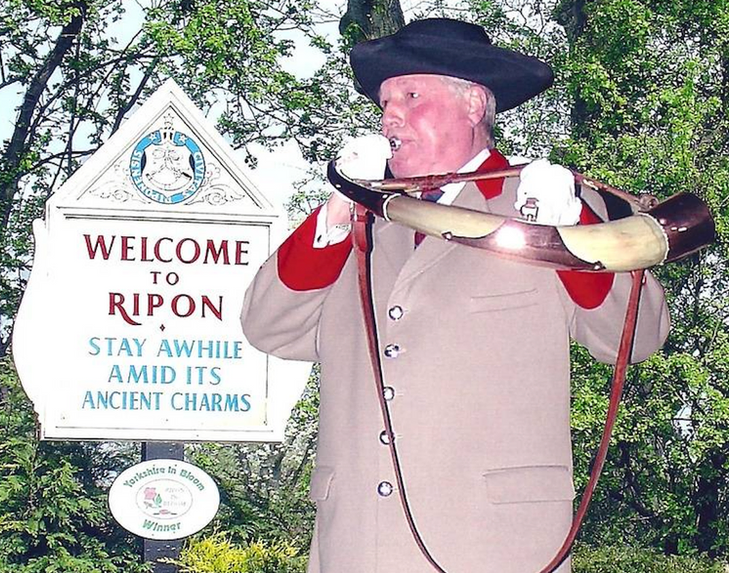The Town That Keeps Tooting Its Own Horn
The English city of Ripon (here’s a map) isn’t all that different from any other city in the area. There are schools and churches, shops and parks, and everything in between. There are even three museums and an equestrian racetrack. In the middle of the public square is the Ripon Obelisk, a centuries-old monument topped by a weathervane, marking the city’s economic center.
And every night, at 9 PM local time, you’ll find one of these guys at the Obelisk, wearing a three-cornered black hat and carrying a really big horn. And if you’re in the neighborhood, you may want to check it out — he’s carrying out what is very likely the world’s longest-running daily municipal tradition.

The role of the Ripon Hornblower dates back to the year 886 — yes, more than a millennium ago. As the BBC explains, “that was Saxon times, and also troubled times. The Vikings were raiding up and down the east coast and occupying parts of the country.” Newer settlements lacked any semblance of government or security and therefore were at particular risk from raiders and local thieves alike. Ripon was one of those settlements. When King Alfred the Great visited the area, he saw the potential for Ripon to thrive and granted it a royal charter, making it an official city under his protection. But he also wanted the people of Ripon to protect themselves. So, Ripon, again per the BBC, instituted the following routine:
It was therefore decided to appoint a wakeman. That was a man who would stay awake and patrol the settlement and the surrounding areas from dusk till dawn. He kept a watchful eye for any approaching enemy or troublemakers, while the rest of the people slept safely in their beds. It was further decided that the wakemen should put the charter horn to good use. He would sound it at the four corners of the market cross each evening at 9pm to let the people know that the watch was set and he was now on patrol.
Fast forward a thousand years or so and the Vikings are long gone, of course, and today, Ripon has a modern police force. But the tradition of sounding the start of the overnight watch never went away. Every night at 9 PM, the tradition repeats. A hornblower goes to the Obelisk, stops at one corner of the monument, blows his horn, goes to the second corner, blows the horn again, and then repeats the same for the other two corners. For the first 750 or so years of the tradition, the watchman was also the town’s de facto mayor — as the person who set the night watch, he was also seen as the head of the police force. And when Ripon elected its first mayor in 1604, the horn-blowing tradition added a new step: at the end of the horn-blowing, the watchman or watchwoman finds the mayor, tips their cap, and states “Mr. Mayor, the watch is set.” (Per a reddit comment, there’s “a local legend that hornblowers in the past have located the mayor at … not his own house. But a job’s a job, so they made their announcement outside and left.”)
The tradition has continued without permanent interruption since its beginnings. In the past, there could be a missed night here or there, particularly if the hornblower fell ill or if the weather was truly awful. To mitigate that, today, there are multiple people appointed to the hornblower role by the mayor. And due to COVID-19, the tradition went indoors from the spring of 2020 to midsummer 2021; per a local blog post, “With people not allowed to meet in groups or outdoors, this ancient ceremony [had] to adapt to [the] situation. The three present Hornblowers – Wayne Cobbett, Richard Midgeley, and Alison Clark, who perform the ceremony on a rotational basis [continued] the tradition by still blowing the horn every night. Whilst this [was] not done in the market square, they [did] it at their homes and [shared] footage each day on the Hornblower’s official Facebook page,” which you can find here.
If you want to see the tradition in action but can’t make it to Ripon, here’s a video of the ceremony from 2012.
Bonus fact: If Vikings had visited Ripon, it’s likely that watchman’s horn would have been the only one present, despite the fact that if you Google “Viking helmet,” almost all of the images are of helmets with horns. But that’s probably ahistorical, as Smithsonian explains, “there is no sign that Vikings really wore horned helmets.” The Gjermundbu helmet — the only reconstructable Viking helmet discovered thus far — shows no sign of horns. Most likely, the myth comes from artists who depicted the raiders a millennium after the Vikings’ heyday; again, per Smithsonian, “the legend likely originated with Scandinavian artists in the 1800s, who popularized portrayals of the nomadic raiders wearing the equipment in their works.”
From the Archives: Why Dyeing Rhinos May Keep Them From Dying: Another story about horns.
